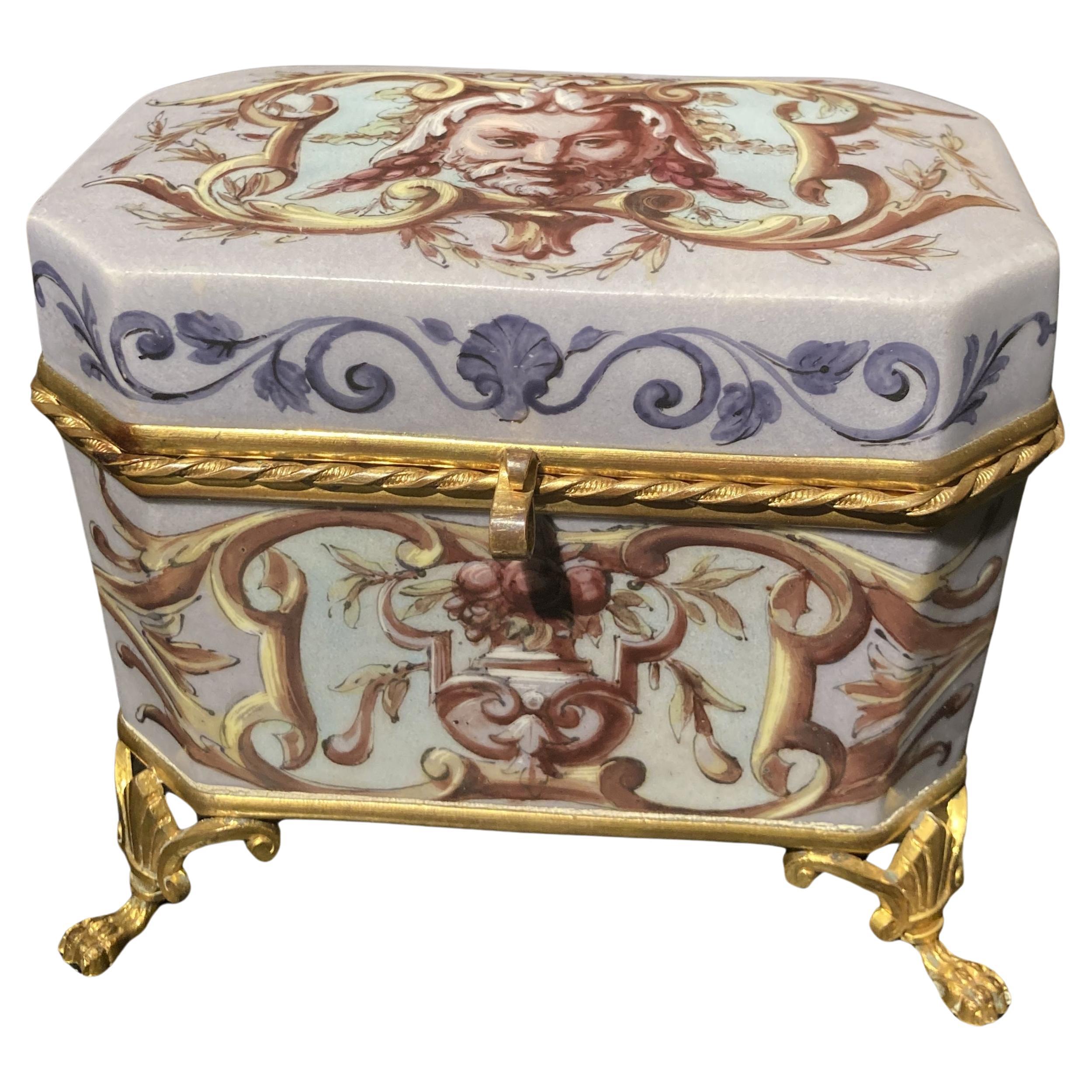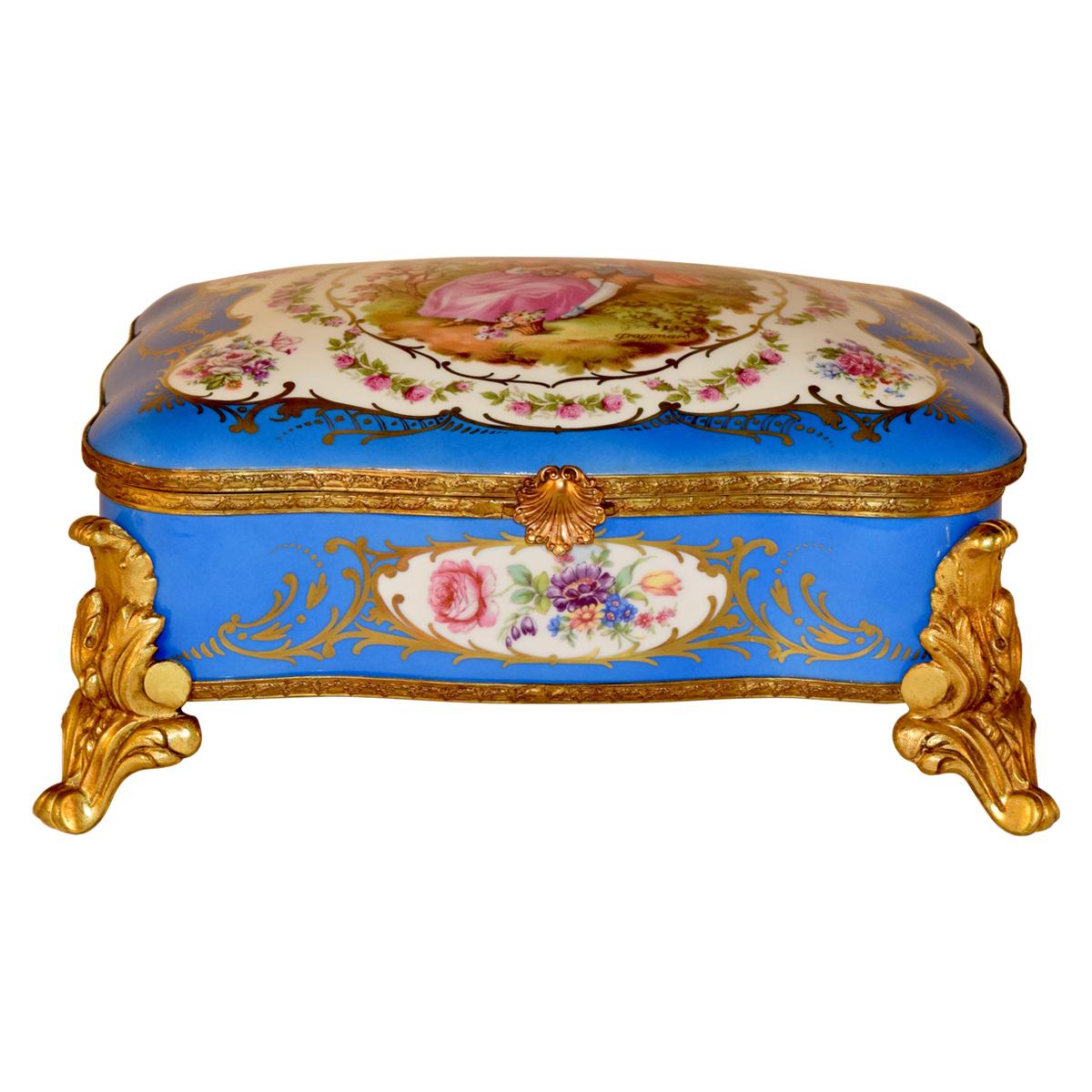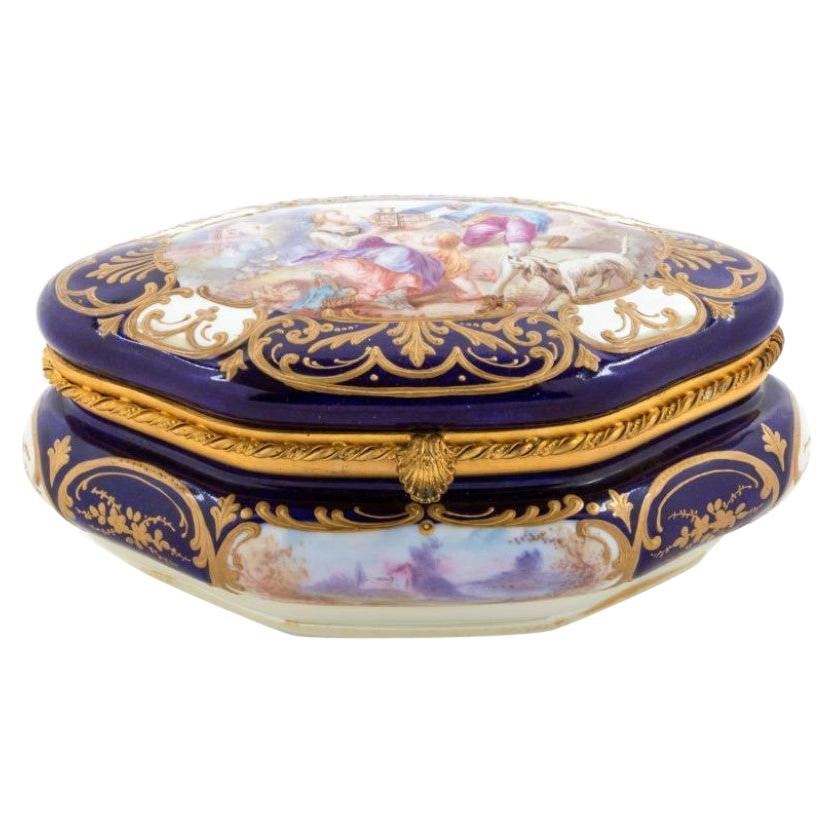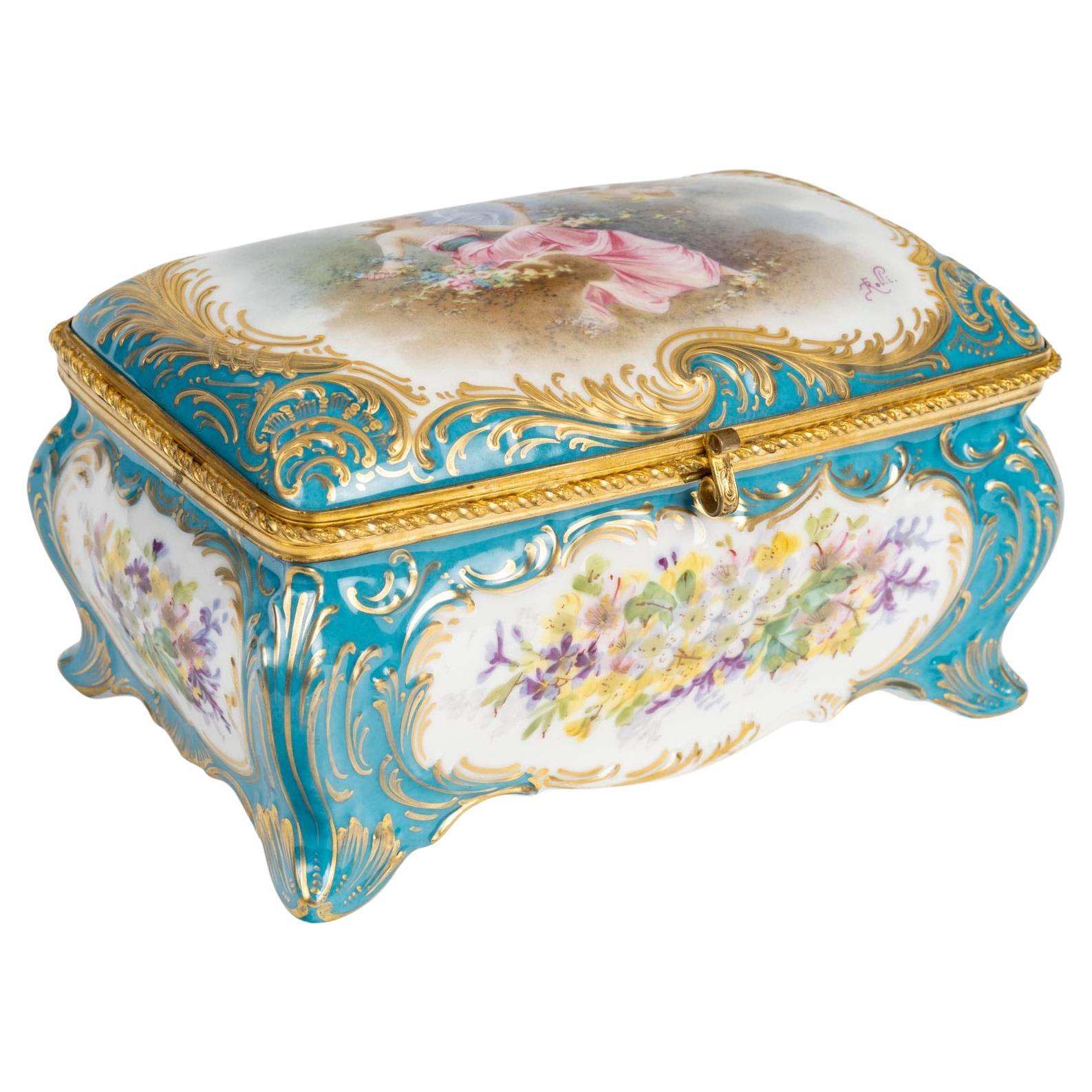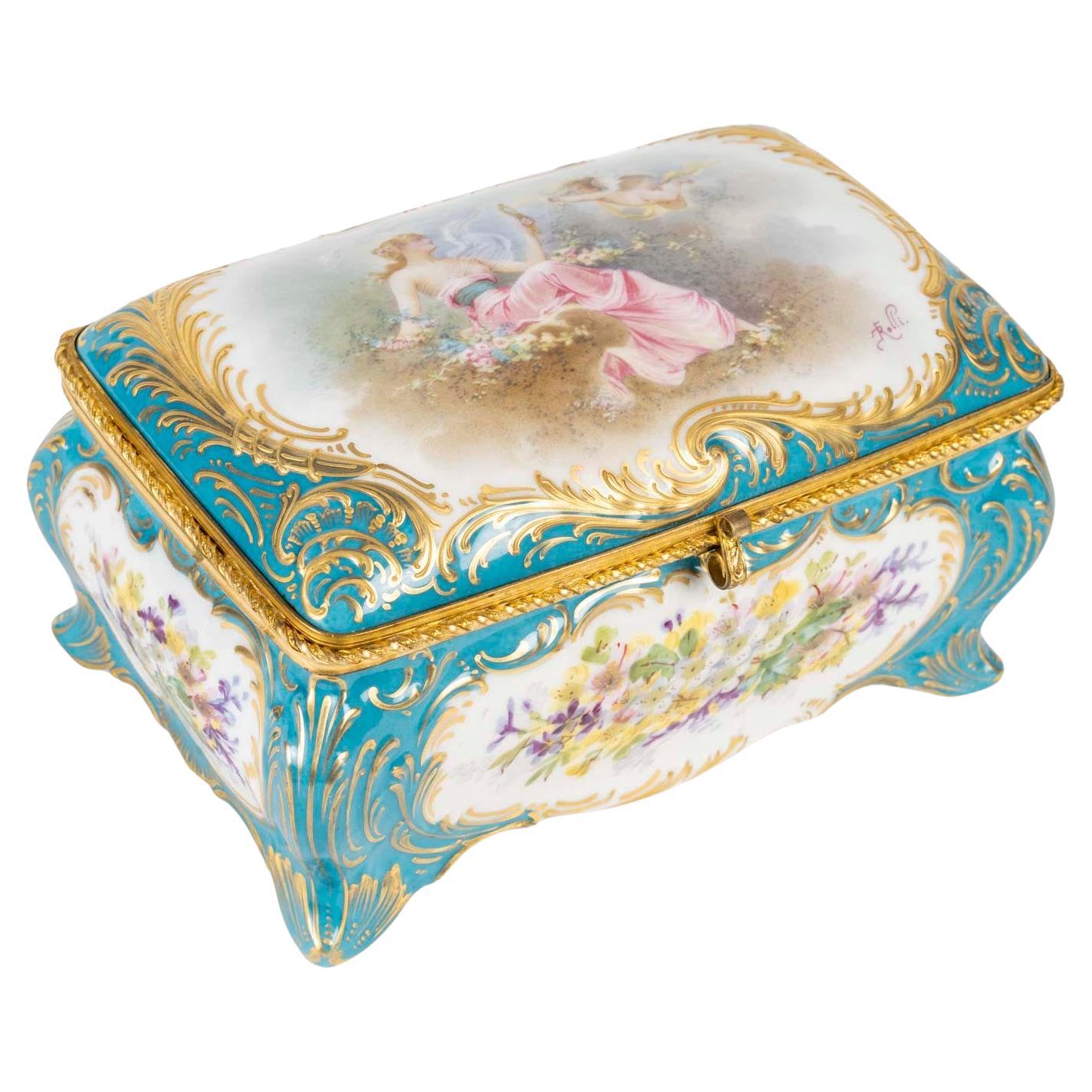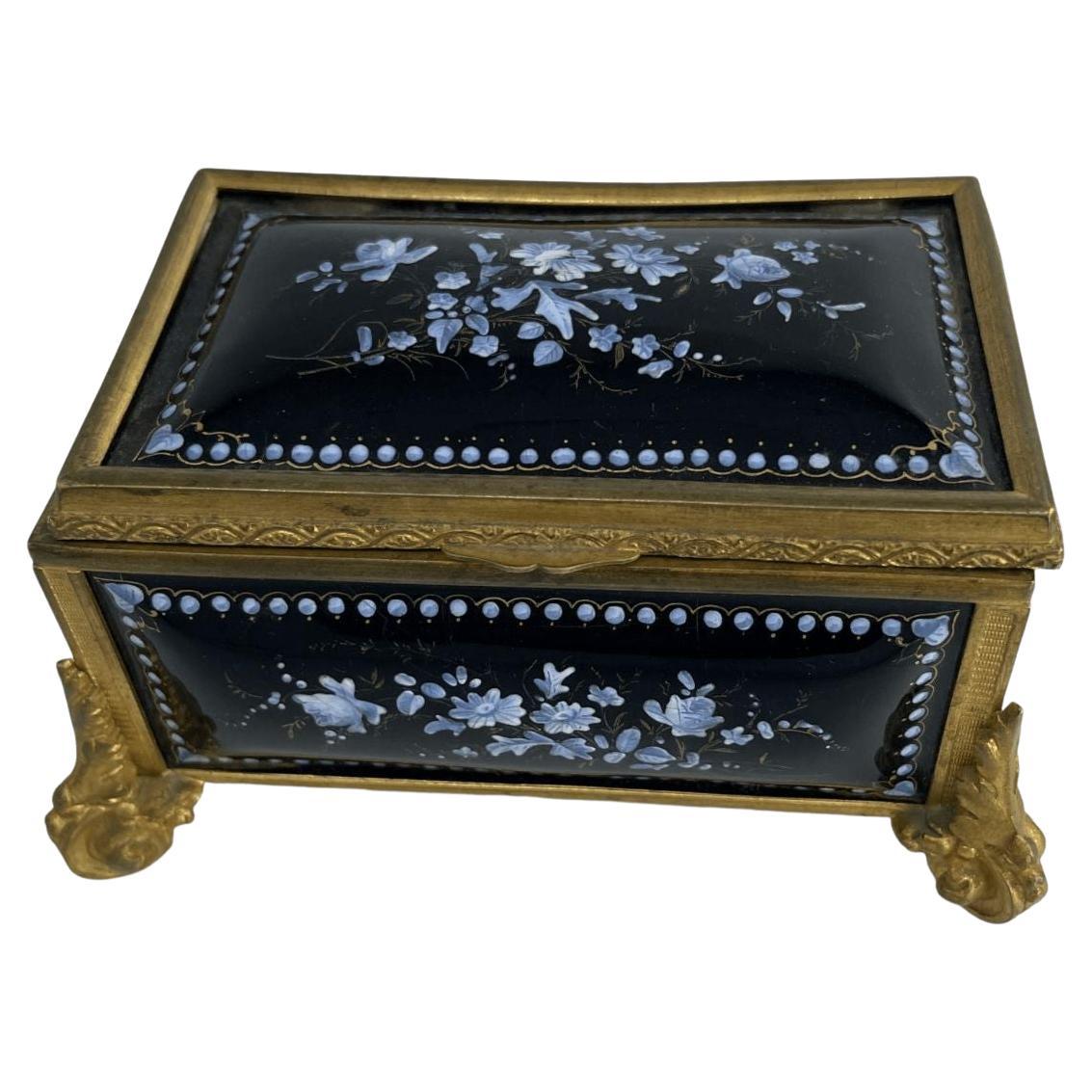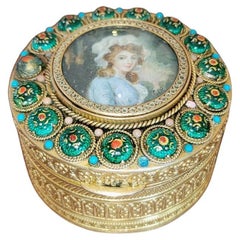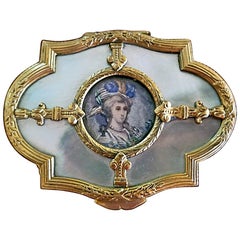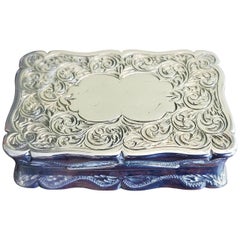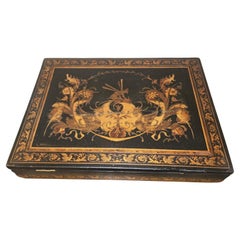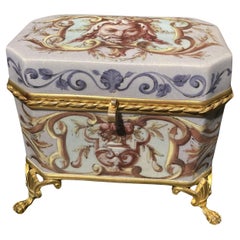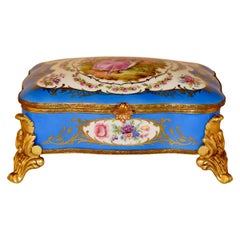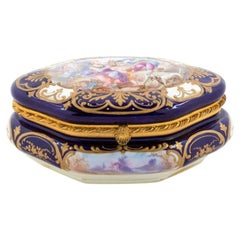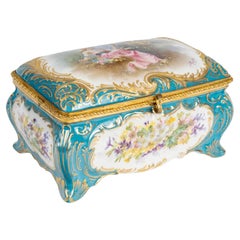Items Similar to 19th Century Samson Paris Porcelain Trinket Box
Want more images or videos?
Request additional images or videos from the seller
1 of 16
19th Century Samson Paris Porcelain Trinket Box
$1,100
£827.11
€960.48
CA$1,536.13
A$1,703.68
CHF 894.69
MX$20,922.38
NOK 11,325.91
SEK 10,680.48
DKK 7,166.21
Shipping
Retrieving quote...The 1stDibs Promise:
Authenticity Guarantee,
Money-Back Guarantee,
24-Hour Cancellation
About the Item
Presenting a gorgeous French 19th century Samson Paris Porcelain Trinket Box probably by Edme Samson.
Marked on the base with “Made in France” and unmistakably in the style and manner of Samson.
The lid features hand painted floral bouquets on an ivory porcelain background with gold edging, surrounded by a sky blue lid with gold web or crackling effect.. The lid is hinged and the lid and base are edged in floral gilt metal mounts with Fleur De Lis clasp. It sits on 4 gilt metal or ormolu feet. The sides are likewise hand decorated.
This wonderful antique hand painted box is just bursting with History. Inspired by Edme Samson of Samson & Co., Paris. we believe (based upon the markings and natural aging) that it was made between 1880– 1890 in France and was meant to resemble an antique of a much earlier period. It is very similar to Sevres pieces with it’s color, decoration and design.
Samson specialized in reproducing antiques from the 1600 and 1700s. One of his most interesting works was his Heraldic or Armorial pieces. With this medium sized box, he was not only copying the larger porcelain caskets or coffin boxes used by royalty in the 1700’s, but he was turning it into an item the current populous needed, an elegant box to hold their new love’s trinkets. And if it looked as if it had belonged to a Knight or Royalty, all the better.
The box is old and shows some of it’s age but is in overall excellent condition. There are no cracks or chips.
Quality piece of lovely size!
Edmé Samson (b Paris, 1810; d Paris, 1891), founder of the porcelain firm Samson, Edmé et Cie (commonly known as Samson Ceramics), was a famous copyist (and perhaps forger) of porcelain and pottery.[1] The firm produced high-quality copies or imitations of earlier styles of porcelain, mainly 18th-century European and Chinese and Japanese porcelain, but also earlier styles such as Italian maiolica.
Samson began his career by making service and set piece replacements in the late 1830s. In 1845 he opened the ceramics firm Samson, Edmé et Cie at 7, Rue Vendôme (later Rue Béranger) in Paris, with the intention of supplying reproductions of ceramics on display in museums and private collections. The factory was moved to Montreuil, Seine-Saint-Denis in 1864 by Samson’s son, Emile Samson (1837–1913). The firm either drew inspiration from other factories, or directly copied their pieces. 18th-century designs from the factories of Meissen, Sèvres, Chelsea, Worcester and Derby were among the reproductions Samson, Edmé et Cie produced, among designs copied from the other major European factories.
During the 19th century, the collectors’ market for antique fine china was considerable, and Samson’s firm reproduced ceramics in a breadth of styles including the faience and maiolica types of Italian pottery, Persian style dishes, Hispano-Moresque pottery (a blending of Islamic and European motifs, produced during the 13th to 15th centuries), plates in the FitzHugh pattern, as well as plates in the manner associated with Bernard Palissy. Also copied by the Samson firm were the early Qing dynasty famille rose and famille verte Chinese porcelains and the so-called “Imari wares”, named for the Japanese port where a type of richly decorated porcelain made at Arita was shipped. The firm exhibited at the International Exposition (1867) and the Exposition Universelle (1889).
Samson, Edmé et Cie did not set out to produce copies with the intention to deceive, and claimed all reproductions the firm produced would be distinctly marked to avoid confusion with the originals. However, many of its products have been passed off as originals.
The Samson firm, in many instances, attempted to distinguish their reproductions from originals. The Samson wares were produced in hard-paste porcelain, while many of the originals would have been produced from soft-paste porcelain. The glazes utilized by the Samson firm were often glossy and somewhat glassy, the modeling stiffer, or wrong in scale, the decoration was often too heavy, and colors were often inaccurate. Leading many experts to conclude that Samson, and his firm, were merely enthusiastic, if sometimes clumsy, copyists.
On the other hand, some Samson reproductions have only been detected by recognition of anachronistic details. Samson copies of Meissen pieces have passed for originals, since the blue underglaze ‘Ss’, Edmé’s mark, can be removed and substituted with false marks. Additionally, an 1880 reproduction piece by Samson, of a British East India Company armorial plate, shows evidence of scratchings, perhaps in an attempt to erase the Samson mark and pass the plate off as an original. Further complicating authenticity, numerous reproductions of Chelsea and Derby figures bear marks other than his trademark ‘Ss’, and in some instances bear no mark at all.
It is impossible to determine when, by whom, and for what reason the Samson marks might have been removed. However, during the same period, other companies, such as Jacob Petit of Fontainebleau, were producing reproductions similar to those created by the Samson firm. In Hungary the Herend company produced famille rose pieces and armorial plates. However, unlike the Samson firm’s marks, Herend utilized both impressed marks and painted ones, which cannot be erased or removed.
The Samson, Edmé et Cie company continued to produce porcelain and pottery until 1969. The salesroom models were sold in 1979 by Christie’s, London. Today many of the Samson’s pieces are collectors’ items. Ironically not all pieces attributed to Samson are actually Samson: there were many other Paris workshops producing similar ‘copies’ of earlier ceramics at the same time. Many Samson marks were removed from the piece, leaving just the assumed mark of the piece they had copied; often this is visible as a ground patch to the base. This was done in order to sell the item as the genuine article. Some pieces described as Samson were actually produced by Herend, Hungary.
- Creator:Samson & Cie (Maker)
- Dimensions:Height: 4 in (10.16 cm)Width: 5.5 in (13.97 cm)Depth: 5.75 in (14.61 cm)
- Style:Louis XVI (In the Style Of)
- Materials and Techniques:
- Place of Origin:
- Period:
- Date of Manufacture:1880-1890
- Condition:Wear consistent with age and use. Very Good original condition with no cracks or chips. Colors still vibrant and only some minor rubbing and aging to the ormolu mounts.
- Seller Location:Dallas, TX
- Reference Number:1stDibs: LU3978120981772
About the Seller
4.9
Vetted Professional Seller
Every seller passes strict standards for authenticity and reliability
Established in 2015
1stDibs seller since 2018
390 sales on 1stDibs
Typical response time: 2 hours
- ShippingRetrieving quote...Shipping from: Dallas, TX
- Return Policy
Authenticity Guarantee
In the unlikely event there’s an issue with an item’s authenticity, contact us within 1 year for a full refund. DetailsMoney-Back Guarantee
If your item is not as described, is damaged in transit, or does not arrive, contact us within 7 days for a full refund. Details24-Hour Cancellation
You have a 24-hour grace period in which to reconsider your purchase, with no questions asked.Vetted Professional Sellers
Our world-class sellers must adhere to strict standards for service and quality, maintaining the integrity of our listings.Price-Match Guarantee
If you find that a seller listed the same item for a lower price elsewhere, we’ll match it.Trusted Global Delivery
Our best-in-class carrier network provides specialized shipping options worldwide, including custom delivery.More From This Seller
View AllEarly 19th Century French Gold Box with Enamel and Miniature Portrait
Located in Dallas, TX
PRESENTING A STUNNING Early 19C French Gold Box with Enamel and Miniature Portrait.
Box made with brass but has been plated with 18ct Gold with beau...
Category
Antique Early 19th Century French Grand Tour Jewelry Boxes
Materials
Gold, Enamel
18th Century French Louis XVI Ring Box with Miniature Portrait of Lady
Located in Dallas, TX
PRESENTING A STUNNING little French Ring Box from the 18th Century, namely a French Louis XVI Brass and MOP Box with Miniature Portrait of Lady.
Box inlaid wi...
Category
Antique Late 18th Century French Louis XVI Jewelry Boxes
Materials
Brass
19th Century Sterling Silver Snuffbox Birmingham 1848 by Rolason Bros
By Rolason Brothers
Located in Dallas, TX
Lovely little sterling silver snuffbox, fully hallmarked with gold plated interior.
Lovely chasing on lid and sides, classic high Victorian repousse w...
Category
Antique Mid-19th Century English High Victorian Sterling Silver
Materials
Sterling Silver
$585 Sale Price
54% Off
19C British Tunbridgeware Micro-mosaic Lap Desk - RARE
Located in Dallas, TX
PRESENTING an ABSOLUTELY GORGEOUS and EXTREMELY UNIQUE and RARE 19C British Tunbridgeware Micromosaic Lap Desk.
This lap desk is unlike any of it’s kind we have seen before.
From c...
Category
Antique Mid-19th Century English High Victorian Decorative Boxes
Materials
Boxwood, Maple, Walnut
Wedgwood Jasperware Pale Blue Small Circular Lidded Vanity Box
By Wedgwood
Located in Dallas, TX
PRESENTING A LOVELY Wedgwood Jasperware Pale Blue Small Circular Lidded Vanity Box.
Made by Wedgwood in England in 1982 and fully and properly marked/stamped on base.
Marked: “Wedgwood, Made in England …. “PH” … “T” ….. “82”.
2.25 inches tall lidded vanity box with a diameter of 3.25 inches.
Rolling vine and grape cameo reliefs, all over the lid and base sides.
Fabulous large pointed finial on the lid with floral cameo reliefs on the sides.
In very good original condition with no chips or cracks.
A ‘PERFECT’ match for the larger and almost identical, lidded jasperware box...
Category
20th Century English Neoclassical Revival Decorative Boxes
Materials
Ceramic
19C Anglo Indian Bombay MOP Sadeli Mosaic Trinket Box
Located in Dallas, TX
PRESENTING a LOVELY 19C Anglo Indian Bombay MOP (Mother of Pearl) Sadeli Mosaic Trinket Box from circa 1875-85.
Gorgeously detailed and hand-crafted ‘sadeli mosaic’ inlay, from the Bombay Area, with deep greens with silver, pewter, mother of pearl, bone and ebony in geometric patterns.
The box case, is made of sandalwood but completely covered in MOP, bone, faux ivory, ebony and mosaic inlay.
Edged with faux ivory and banded with a different pattern of sadeli mosaic.
Some minor damage to the top (repair is obvious in pics) and ivorine replacements to some edging, but it still a BEAUTIFUL BOX and of real QUALITY!
The mosaic work is FABULOUS!
Box opens to reveal its original blue velvet lining.
It sits on 4 (recently added) silvered button feet.
SADELI MOSAIC: “Anglo Indian boxes were made in India for the English residents from the early part of the 18th century. They were brought back or sent back to England usually by the people who had commissioned them. From the beginning of the nineteenth century they were imported more commercially, although not in any significant numbers until the middle decades. They were very highly valued, especially the early ones, to the extent that the designs were copied on late 19th and early 20th century tins.
The ancient art of Sadeli Mosaic is said to have been introduced from Shiraz in Persia via Sind to Bombay, a long time before the Anglo Indian boxes were made. It was a technique, which required a high degree of skill and patience. It was executed very lavishly, in that the frequent cuts wasted a great amount of the precious materials used. The workmanship was however more than commensurable to the value of the materials.
Ivory, silver, pewter (or other metals), wood and horn were cut into faceted rods which were bound together to form geometric patterns. When the glue has set, the rods were sliced in transverse sections. This gave the maker a number of angled circular pieces in the original pattern. Several variations of patterns could be achieved by combining the materials in different ways. The ivory was sometimes dyed green to give an extra color.
The mosaic pieces in a combination of patterns, often separated by ivory, ebony, horn or silver stringing were used to veneer sandalwood boxes. In the early boxes, which date from the turn of the 18th to the 19th century, there are large panels of mosaic covering tops and sides of boxes. It took incredible skill to cover such large areas without any shakes or wavering of the pattern. The corners and joins on these boxes are impeccably matched.
The makers (reputed to be Persian) of Sadeli mosaic made in the first two decades of the 19th century displayed a total understanding of the qualities of the different materials they used. They combined substances, which can expand and contract according to atmospheric conditions with others, which are hard and unyielding. The result was a sharp definition of the lines and patterns, which made up the whole design.
On the early boxes the designs look deceptively simple. The fact is, they emerged from a culture, which had mastered geometry and understood how to generate a pattern from a set number of points. The patterns are so harmoniously combined that their incredible complexity is not immediately apparent.
The earliest Sadeli boxes...
Category
Antique Late 19th Century Indian Anglo-Indian Jewelry Boxes
Materials
Silver
You May Also Like
French 19th Century Empire Porcelain and Gilt Bronze Decorative Jewelry Box
Located in Firenze, IT
This French Empire 19th century rectangular porcelain dresser box or jewlery decorative casket has a wonderfully patinated powder blue/cerulean light blue background color and features grotesque masks, architectural vase, fruit, flowers and leafy scrolled design throughout painted as a trompe l’oeil in the round. Ormolu mounts enrich the whole box.
The paintings on this casket are striking as is the color palette used, a wonderful mix of light purple, cream, blue and soft brown.
The lid is centered by a grotesque mask inspired by antiquity. The front, back and sides are profusely decorated with architectural elements, cartouches and volutes. The design is centered by a vase with a fruit arrangement that appear to be plums. The decoration could refer to the allegory of autumn and the mask painted on the lid could refer to Bacchus.
Both the color of the porcelain and the paintings are very unusual and a sign of high quality and uniqueness.The box was most probably given to a high-ranking lady as a gift on the occasion of her marriage, or perhaps after the birth of a child.
The lidded box is fitted with ormolu mounts, hinges and clasp. A gilt bronze band finelly chiseled in the form of a rope adorns the upper part. The trinket box rests on four gilt bronze lion paw feet.
This striking French porcelain box...
Category
Antique 19th Century French Empire Jewelry Boxes
Materials
Bronze, Ormolu
Sevres Style Porcelain Footed Dresser Box, circa 1920
Located in High Point, NC
Sevres style hand painted porcelain dresser box with hand applied ormolu mounts and feet. Wonderful condition.
Category
Early 20th Century French French Provincial Decorative Boxes
Materials
Ormolu
19th Century French Sevres Porcelain Box
Located in Los Angeles, CA
19th century French Sevres Porcelain box.
Category
Antique 19th Century French Jewelry Boxes
Materials
Porcelain
A Sèvres Porcelain Box, Gilt Brass Mounting, 19th Century, Napoleon III Period.
By Manufacture Nationale de Sèvres
Located in Saint-Ouen, FR
A Sèvres porcelain case, gilt brass mounting, 19th century, Napoleon III period.
An important Sèvres porcelain box, 19th century, Napoleon III period, gilt brass mounting.
H: 15.5cm...
Category
Antique 19th Century French Napoleon III Decorative Boxes
Materials
Brass
Sèvres Porcelain Box, Gilt Brass Mounting, 19th Century, Napoleon III Period.
By Manufacture Nationale de Sèvres
Located in Saint-Ouen, FR
Sèvres porcelain box, gilt brass mounting, 19th century, Napoleon III period.
A Napoleon III period box, 19th century, Sèvres porcelain and gilt brass mount.
H: 14cm, W: 26cm, D: 16cm
Category
Antique 19th Century French Napoleon III Decorative Boxes
Materials
Brass
19th C Limoges Hand Painted Porcelain Keepsake Box W Brass Footing
Located in Van Nuys, CA
One-of-a-kind 19th century Limoges hand-painted porcelain keepsake box with brass footing for your consideration.
This delightful porcelain jewelry keepsake box is decorated with ha...
Category
20th Century French Louis XVI Decorative Boxes
Materials
Brass
$1,644 Sale Price
25% Off
More Ways To Browse
Box Clasp
Boxes With Clasp
Call Box
18th Century Gold Box
Old Antique Jewelry Boxes
Antique Jewellery Display Boxes
Antique Metal Jewelry Box
Chinese Jewellery Box
Chinese Jewelry Box
Chinese Jewlery Box
Paris Pottery
Antique Jewelry Box Hinges
19th Century Italian Jewelry
French Old Paris Plates
Antique Jewellery Boxes London
Patch Box
Paris Porcelain Plate
Antique French Blue Box
